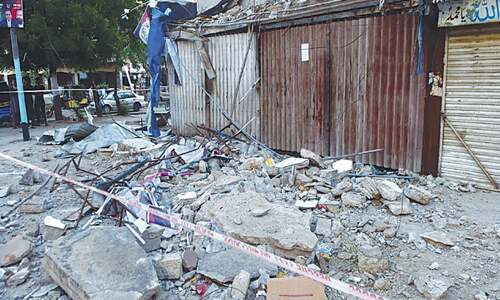KARACHI, May 18: An exhibition of artist Asim Butt’s work titled Rebel Angel drew art lovers in a big number to the Mohatta Palace Museum on Wednesday. The display, which includes paintings, murals, drawings and photographs, will continue till the end of July.
The artist’s work was appreciated by critics and connoisseurs alike as they viewed (some examined) each painting, mural and drawing with great interest. It’s Asim Butt’s sharp eye to paint the human condition that made many believe that if he had lived longer, he would have achieved significant feats in the realm of art. Asim Butt committed suicide in Jan 2010 at the age of 32.
The exhibits embody quite a few themes ranging from the predicament of the underprivileged and the political unevenness that causes disorder in society to the symbiotic relationship between humans and animals, hinting at a connection that’s both natural and deviant. His self-portraits and a series that’s dubbed ‘Character Assassination’ (chalk and charcoal on board) use brilliant shades of black colour as a symbol of darkness, perhaps inner, that enveloped the artist and the people that he often painted.
Asim Butt’s razor-sharp satirising of the elite, too, warrants immediate attention. In an oil-on-canvas painting, titled Trio, two uppity women are seen perched on a couch or a sofa with a black cat striking a languid pose at their feet. The vacuity in the seemingly attentive eyes of the women is more than apparent.
It wasn’t just the hollowness of the affluent or the plight of the oppressed that affected Asim Butt. In a stencil & spray paint work, Doorman, he protests against the demolition of the Metropole hotel, a landmark that depicts a certain era.
The artist also tackles the subject of death in a way that makes it look like an inescapable destiny. His remarkable protest against the emergency rule in 2007 that came in the shape of the ‘eject’ symbol often eclipses his other creative endeavours that are a result of his rebellious attitude to political shortcomings. But some of his other pieces are far more poignant.
Prior to the formal opening of the exhibition, Director of the Mohatta Palace Museum Nasreen Askari said the display was arranged to pay homage to Asim Butt and commemorate his private and public creative endeavours.
She said his inner compass had made him sensitive to the travails of the disenfranchised. She said his art in public spaces represented that tier of society. She said he painted signs and symbols that were simple and direct and were an incisive response to the issues that perturbed him. She commented that the eject symbol had become a visual imperative. She lauded the efforts of her co-curators Nafisa Rizvi, Sheherbano Husain and Arif Pervaiz for making the exhibition possible.
In her speech, Sheherbano Husain said she and the late artist often engaged in a professional discourse and in the last two years before his death they’d become close friends. She said his objects were lucid and singularly focused and his paintings exuded a pulsating energy. On his erudition, she opined, “He was anything but literal” and argued the man was inseparable from his art.
Sabeen Mahmood recollected her memories of Asim Butt and recounted the time when he collaborated with her on a project. She said he was pure and uninhibited like a child. She also touched upon the generosity of his spirit.
Journalist Raza Rumi was the last speaker of the evening. He talked on the legacy of Asim Butt’s public art.
He said his work was a direct challenge to the conformist, studio art. He said his murals at Abdullah Shah Ghazi’s shrine were about the people rejected by the conventions of society – glue-sniffing children, prostitutes, etc.
He informed the gathering that in 2005 Asim Butt formed the Karachi Stuckist Group and indigenised it in the Pakistani context. He particularly highlighted two of his work – one related to the proposed Shariat Bill and the other to a bench outside Minar-i-Pakistan. He said Asim Butt challenged the sacred cow of the Two-Nation theory employing effective symbolism.














































Dear visitor, the comments section is undergoing an overhaul and will return soon.